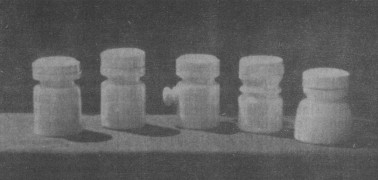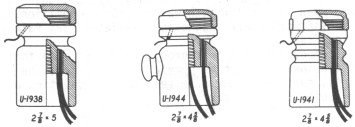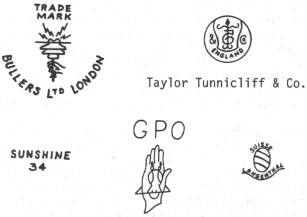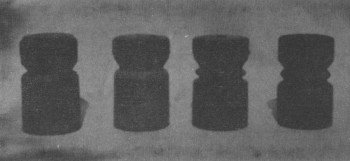Foreign Insulators
by Marilyn Albers
Reprinted from "INSULATORS - Crown Jewels of the Wire", December 1982, page 5
Potheads and Spur Insulators
Collectors of foreign porcelains seem to be generally excited about finding the
peculiar shaped insulator nicknamed the "Pothead". It has a top cover
which unscrews from the rest of the insulator and resembles a jar of peanut
butter with a lid. This insulator design was invented by Colonel Sir T. F.
Purves and J. Sinnott of London, England, covered by U.S. Patent #898,921,
September 15, 1908, and first introduced at that time in England. English
manufacturers were Bullers Ltd. (London) and Taylor Tunnicliff and Co. (Hanley).
In the U.S. we would call this design a "dry spot" insulator. In
England it is referred to as a terminal insulator. Quoting from Worldwide
Porcelain Insulators, co-authored by Jack H. Tod and myself, "Styles vary
as to one or two holes for lead in wires, etc. The purpose of these insulators
is to provide a "dry spot" on the insulation of the lead-in wire,
thereby breaking the wet weather shorting path from the line wire over the
insulation of the lead-in wire to ground." It provides the cheapest and
most efficient method which has ever been devised of connecting aerial wires to
covered leads.
Quoting now from some xeroxed material sent to me by Alex Burnett
(Vermillion, Alberta, Canada), which I believe was taken from a book called
Telephony (author ?), "The connection between the open wire and the covered
lead is made in a cavity formed at the top of the insulator; this cavity is then
filled with insulating compound and covered by a screw cap. In this way a
lead-covered cable may be carried up to the insulator, where the end is
effectively sealed by the compound. Telephone subscribers' circuits are led in
with lead-covered cable having 2-wire enameled and F.P.-covered 10 lb.
conductors.
"The insulating compound is soft enough to be pressed cold into
the insulator top and is not materially affected in consistency by changes of
temperature met with in practice. It has a high insulation resistance when dry,
and this is maintained when in contact with water. Its composition is by weight:
56% French chalk (magnesium silicate), 32% Palm pitch and 12% coal tar.
"The compound should be thoroughly pressed into the cavities of the
insulators so as completely to enclose the bare wire joints, care being taken to
see that the cavities are quite dry before it is put in."
A couple of my
pothead insulators from England do have this strange putty-like substance in
the top cavity, and it was so interesting to me to learn what it was made of and
why it was there!
These insulators were made of white glazed porcelain or black
composition. Depending on the size of the insulator, the small threaded pinholes
were made to screw directly onto either a 5/8" or a 3/4" steel spindle
(pin).
One other manufacturer of the "pothead" insulator was Sunshine
Porcelain Potteries of Melbourne, Victoria, Australia. According to information
coming from Laura Van der Endt and Dawn Hole, who both live in Australia, this
company sold to a switchgear manufacturer which eventually ceased all
manufacture of porcelain products. Apparently other styles of insulators had
been made as well. I have no other information about Sunshine Potteries, i.e.,
history, dates, etc. However, the pothead insulator I have with their trademark
is dated 1934.
A Swiss company known as Suisse Langenthal also produced the
"pothead" insulator, as well as many other styles of insulators, and
is possibly still in business. We have no other information about this company,
not even where in Switzerland it was located. Can you help? Specimens we
borrowed from Steve Watkins (Portland, Oregon) and Joe Tuma (East Islip, New
York) for drawings were dated 1953 and 1954 respectively.
The picture below
shows several variations of the "pothead" insulator.


Viewed from left
to right we see examples of the following manufacturers:
- Taylor Tunnicliff
and Co.; incuse trademark on top of lid; patent dates on skirt. (A new variation
and as yet no U-number assigned.)
- Sunshine Potteries; incuse trademark on
lid: This is U-1938.
- Taylor, Tunnicliff and Co.; known as a terminal
"spur" insulator. This is U-1944.
- Unidentified English
manufacturer; incuse letters G.P.O. (General Post Office) plus a
"hand" trademark on the skirt. This is U-1941, known as a double
groove "pothead".
- Suisse Langenthal -- trademark stamped in green
ink up inside skirt. (New variation, not yet classified.). Insulator borrowed
from Steve Watkins.

Following is a picture of several variations of the
"pothead" in black composition.

Again reviewed from left to right:
- Manufacturer unknown; raised letters G.P.O. on Lid; probably English.
- Manufacturer unknown; raised figures on lid are: NO 16 -- L R; found in New
Zealand, but probably English.
- Manufacturer unknown; marked: NZPO 69 (New
Zealand Post Office); double groove "pothead" made of hard rubber --
extremely light weight; found in New Zealand.
- Manufacturer unknown; raised
letters: LEA NZPO 62; double groove "pothead"; found in New Zealand.
Spur insulators:
One particular design of "pothead" had a side knob,
and in the first picture I showed you it is #3, and is referred to as a
"terminating spur insulator". It is the white porcelain insulator
right in the center. It came into use some time between 1912 and 1920. The
British Post Office referred to it as their insulator #21. Still another British
design of spur insulators is their #10, described as "a small double
groove, double shed, Sinclair (patent name) insulator with side knob for a
5/8" "spindle". It was introduced before 1907 and was at first
available in either white porcelain or black composition. It was not until
sometime between 1946 and 1955 that brown porcelain was added to the list. The
example shown in the picture below is our U-1578, and it is brown!
Again
quoting from our Worldwide Porcelain Insulators book, "Spur insulators are
for applications where the direction of a wire abruptly changes from a
horizontal to a vertical route. Also similarly, when a tap line is taken off the
through line either vertically or nearly so. The reason this side knob also
appears on some designs of "dry spot" (pothead) insulators is that the
lead-in wires nearly always run vertically."
| 